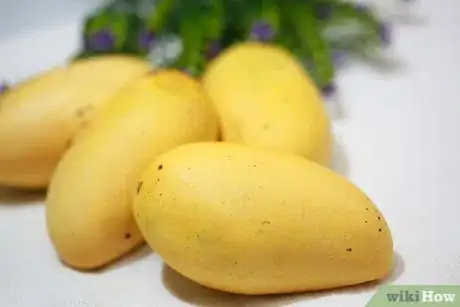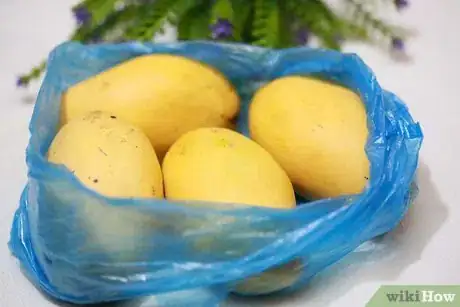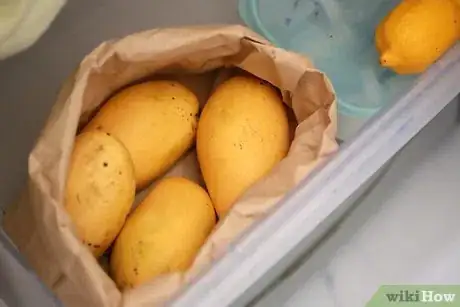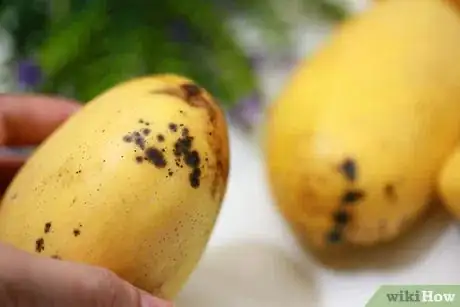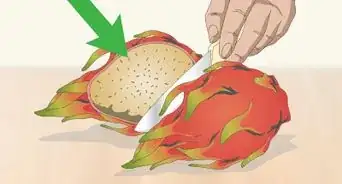This article was co-authored by Markeicha Dulaney. Chef Markeicha Dulaney is a Personal Chef and Founder of Sweet Monáe Personal Chef Services in 2015 in South Florida. She has over 22 years of experience in the kitchen and provides customizable menus to meet the dietary needs, taste preferences, style, and budget of each client. She also specializes in weekly in-home chef services, all-inclusive pro-chef services, boutique catering, and pantry organizing services. She was featured in The Knot's "Table for Two" YouTube episodes and has also been featured in Real Simple Magazine article on "What routines save you the most time.” Chef Markeicha Dulaney graduated with an Associate's Degree from the Pennsylvania Culinary Institute of Culinary Arts and is a longtime member of the USPCA (United States Personal Chef Association).
There are 8 references cited in this article, which can be found at the bottom of the page.
wikiHow marks an article as reader-approved once it receives enough positive feedback. In this case, several readers have written to tell us that this article was helpful to them, earning it our reader-approved status.
This article has been viewed 326,699 times.
It can be tempting to buy a bunch of mangoes when they are in season. Sometimes you’ll find yourself with extras and want to save them for later. Mangoes are sensitive to the elements and need a little care to prevent getting spoiled. Keeping them in secure, temperature-controlled containers can help them last!
Steps
Storing Mangoes for the Short Term
-
1Check if your mangoes are ripe. The ripeness of your mangoes can be determined by their firmness and smell. Unlike most fruit, the color of mangoes does not matter when it comes to ripeness.[1]
- Unripe mangoes are hard, sturdy, and don’t have a noticeable scent.
- Ripe mangoes are soft, but not so soft that they are mushy. They have a fruity, pleasant smell.
-
2Store unripe mangoes in a dark, room temperature container. Room temperature storage helps unripe mangoes retain their flavor without spoiling too fast. Jars with air flow and plastic bags can protect your mangoes from pests without blocking out oxygen.[2]
- Store them preferably in a paper bag to allow them to ripen.
- Check on your mangoes every 2 days until they are ripe. Depending on when you bought your mangoes, they can take up to 8 days to ripen.[3]
Advertisement -
3Store ripe mangoes in the fridge so they stay retain more of their flavor. Once mangoes are ripe, you can put them in colder storage like the fridge.
- Fresh mangoes in the fridge can last up to 6 days.
- The internal temperature of your fridge should stay at around 40°F (4°C).[4]
-
4Watch out for signs that the mangoes have turned rotten. After six days, ripe mangoes are likely to show symptoms of rot like mushy, black skin and a sour smell. If the discoloration is inside the mangoes, throw them away.[5]
- Mangoes that only have little spots of discoloration on the skin can still be used for smoothies.
Freezing Mangoes for the Long Term
-
1Cut your mangoes into cubes or slices for easier packaging. Mangoes stored for off-season enjoyment should be cut into little pieces so they can be thoroughly frozen. The pieces should be small enough that you can keep them in a Ziploc bag.
- Cut the mango parallel to its large seed, then score the flesh from the skin in small cubes using the tip of a knife.
- Most people peel the skin off of mangoes when freezing, but this is not strictly necessary. The only difference is that the mangoes may take a little longer to freeze and thaw.[6]
- Try a potato cutter or apple peeler if you’re not comfortable peeling mango skin with a knife.[7]
-
2Pack and seal Ziploc bags with your leftover mangoes. Put your mango pieces into Ziploc bags without placing any pieces on top of each other. Push as much oxygen out of the bags as possible before you seal them.
-
3Place your Ziploc bags in the freezer horizontally. Your bags should not stand up against a wall, otherwise the fruit won’t freeze evenly. Make sure your freezer is consistently at or under 0°F (-18°C).[8]
-
4Eat your frozen mangoes within 6 months of placing them in the freezer. Take your mangoes out of the freezer and let them thaw in the fridge. Once the cubes soften, you can enjoy a healthy snack![9]
- Black spots on frozen mangoes are a sign of freezer burn. The mangoes will still be safe to eat, but won’t taste as good.
Expert Q&A
-
QuestionHow do you store half of a mango?
 Markeicha DulaneyChef Markeicha Dulaney is a Personal Chef and Founder of Sweet Monáe Personal Chef Services in 2015 in South Florida. She has over 22 years of experience in the kitchen and provides customizable menus to meet the dietary needs, taste preferences, style, and budget of each client. She also specializes in weekly in-home chef services, all-inclusive pro-chef services, boutique catering, and pantry organizing services. She was featured in The Knot's "Table for Two" YouTube episodes and has also been featured in Real Simple Magazine article on "What routines save you the most time.” Chef Markeicha Dulaney graduated with an Associate's Degree from the Pennsylvania Culinary Institute of Culinary Arts and is a longtime member of the USPCA (United States Personal Chef Association).
Markeicha DulaneyChef Markeicha Dulaney is a Personal Chef and Founder of Sweet Monáe Personal Chef Services in 2015 in South Florida. She has over 22 years of experience in the kitchen and provides customizable menus to meet the dietary needs, taste preferences, style, and budget of each client. She also specializes in weekly in-home chef services, all-inclusive pro-chef services, boutique catering, and pantry organizing services. She was featured in The Knot's "Table for Two" YouTube episodes and has also been featured in Real Simple Magazine article on "What routines save you the most time.” Chef Markeicha Dulaney graduated with an Associate's Degree from the Pennsylvania Culinary Institute of Culinary Arts and is a longtime member of the USPCA (United States Personal Chef Association).
Personal Chef Peel and cut the half of the mango that you plan on eating. Then, leave the other half unpeeled with the seeds intact. Wrap it up tightly with plastic wrap and keep it in the refrigerator so it stays fresh. Once you remove the skin, the mango will start oxidizing, which isn't going to be good.
Peel and cut the half of the mango that you plan on eating. Then, leave the other half unpeeled with the seeds intact. Wrap it up tightly with plastic wrap and keep it in the refrigerator so it stays fresh. Once you remove the skin, the mango will start oxidizing, which isn't going to be good. -
QuestionHow long do mangoes stay fresh when peeled?
 Community AnswerIf you freeze them, they should be fine for a few months. If you don't freeze them and put them in the fridge, they will last about 1 week.
Community AnswerIf you freeze them, they should be fine for a few months. If you don't freeze them and put them in the fridge, they will last about 1 week. -
QuestionWhen I put cubed mango in the refrigerator overnight, it turns black. How can I stop this from happening?
 Community AnswerMangoes oxidize just like apples. Once they have been cut, oxygen in the air interacts with the fruit and causes their color to change. It isn't bad for you, but it looks unappetizing. You can put it in a zip-lock bag and suck the air out of it to slow the process, or just eat it right after you cut it.
Community AnswerMangoes oxidize just like apples. Once they have been cut, oxygen in the air interacts with the fruit and causes their color to change. It isn't bad for you, but it looks unappetizing. You can put it in a zip-lock bag and suck the air out of it to slow the process, or just eat it right after you cut it.
Things You'll Need
- Fridge or freezer storage
- Kitchen knife
- Ziploc bag
References
- ↑ https://spoonuniversity.com/how-to/how-to-tell-if-a-mango-is-ripe-or-not
- ↑ http://www.sbs.com.au/food/article/2016/12/20/mangoes-dont-belong-fridge-fruit-hacks-you-need-know-summer
- ↑ http://www.businessinsider.com/how-to-ripen-a-mango-fast-2016-12
- ↑ https://www.fda.gov/food/resourcesforyou/consumers/ucm253954.htm
- ↑ https://www.thekitchn.com/the-right-temperature-for-your-freezer-quick-kitchen-facts-216070
- ↑ https://skillet.lifehacker.com/how-to-properly-freeze-fruit-for-longer-lasting-freshne-1692241279
- ↑ http://www.extracrispy.com/food/2664/how-to-cut-a-mango
- ↑ https://www.thekitchn.com/the-right-temperature-for-your-freezer-quick-kitchen-facts-216070
- ↑ http://www.stilltasty.com/Fooditems/index/19109
About This Article
The best way to store mangoes depends on whether or not they're ripe and also how long you want to store them for. If your mangoes aren't ripe yet, keep them in a dark container or plastic bag at room temperature until they ripen. If your mangoes are already ripe, you can store them in the fridge for up to 6 days. For long-term storage, cut up the mangoes into slices or cubes, pack them in a freezer bag, and store them in the freezer up to 6 months. If you want to learn how to check your mangoes to see if they're rotten, keep reading the article!
